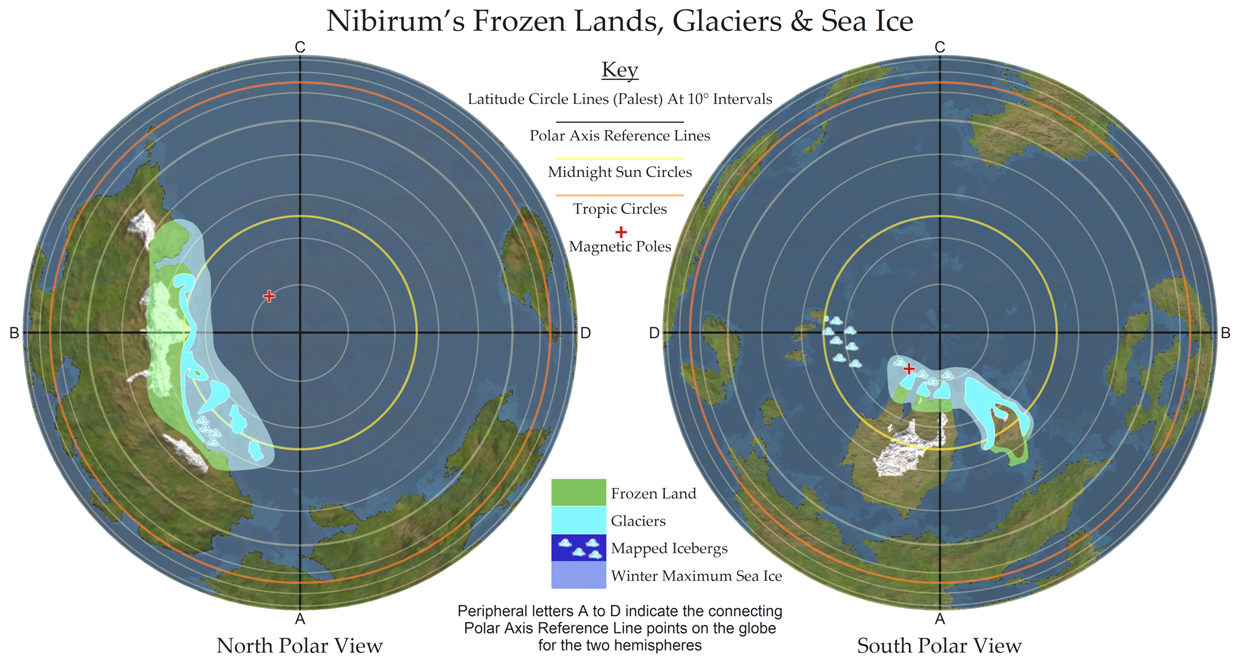Community Atlas: Should Nibirum Have Polar Ice Caps?
 Wyvern
🖼️ 271 images Cartographer
Wyvern
🖼️ 271 images Cartographer
I started thinking about this when working on the geomagnetic and auroral zones polar map for the Nibirum Solar System project. Although no such glacial features are shown currently on the world map or globe graphics in the Atlas, individual mappers have added large-scale glaciers and frozen land elements to the areas nearer the poles in places - including northern Alarius and its three large offshore islands, Seal Island, Ice Peak Isle and North Wind Island; part of the southern tip of The Bleakness in the Forlorn Archipelago; all three "finger-tip" peninsulas of Peredur; and almost all except the northern inland mountain spine of Ezrute. Indications of mobile sea-ice, as floes and icebergs, have been made in parts as well, for areas adjacent to some of the ice-fields other than those of Ezrute.
Geological evidence indicates Earth's polar ice-caps are not permanent features of our planet, and perhaps are only present during Ice Ages, including during parts of the interglacial times between colder periods, like the current interglacial. Such large-scale ice seems to form preferentially on larger, isolated landmasses (that is, ones not directly connected to continental landmasses that extend a lot further from the poles) within roughly 30° of either pole. While the ice can spread over the adjoining sea areas, especially any more or less enclosed ones such as the Arctic Ocean and narrower channels to parts of nearby islands and continental edges, more open oceans seem to restrict its growth. The so-called "permanent" pack ice over the seas is restricted to well within the Arctic and Antarctic Circles in general, and even the maximum winter ice-growth averages no more than to 35° from either pole, very approximately. These limits are further influenced by the local ocean currents. The cold Antarctic Ocean Drift that rings Antarctica seems to help - or perhaps constrains - the pack ice to grow out in a near-concentric fashion from the continent, while the warm North Atlantic Drift means even northern Svalbard, at circa 78°N latitude, often retains open-water access year-round, for instance. However, 180° of longitude away, the Bering Sea between Bristol Bay and Kamchatka often freezes over down to about 55°N latitude, subject to the cold Oya Siwo current.
As both Nibirum's poles are completely open ocean, it is unlikely any large, long-term ice-caps could form there. Nibirum being about 20 million km closer to its Sun than Earth is to its might suggest no ice-caps at all, though that need not be the case, and clearly the extant maps confirm the presence of some large-scale glaciated regions on the planet. Some of these may seem a little anomalous compared to Earth. Peredur has only its southernmost extremities iced-over (though it has many active volcanoes, of course), while neighbouring Ezrute is more or less completely encircled by frozen land, for example. However, ocean currents, volcanism and magical influences could all be invoked as possible explanations.
What I've done here is to prepare a simple global-scale map using the Nibirum Geomagnetics one as its base, showing where the glacial and sea-ice areas are as currently understood, with my own conservative suggestions for the extent the average maximum winter ice-growth could achieve over the adjacent seas. This is not intended as definitive, merely open for discussion, notably by those mappers who have worked on the icy regions already, or who are in the process of doing so presently (particularly in case I've missed or misinterpreted something).
[Image_10684]
Geological evidence indicates Earth's polar ice-caps are not permanent features of our planet, and perhaps are only present during Ice Ages, including during parts of the interglacial times between colder periods, like the current interglacial. Such large-scale ice seems to form preferentially on larger, isolated landmasses (that is, ones not directly connected to continental landmasses that extend a lot further from the poles) within roughly 30° of either pole. While the ice can spread over the adjoining sea areas, especially any more or less enclosed ones such as the Arctic Ocean and narrower channels to parts of nearby islands and continental edges, more open oceans seem to restrict its growth. The so-called "permanent" pack ice over the seas is restricted to well within the Arctic and Antarctic Circles in general, and even the maximum winter ice-growth averages no more than to 35° from either pole, very approximately. These limits are further influenced by the local ocean currents. The cold Antarctic Ocean Drift that rings Antarctica seems to help - or perhaps constrains - the pack ice to grow out in a near-concentric fashion from the continent, while the warm North Atlantic Drift means even northern Svalbard, at circa 78°N latitude, often retains open-water access year-round, for instance. However, 180° of longitude away, the Bering Sea between Bristol Bay and Kamchatka often freezes over down to about 55°N latitude, subject to the cold Oya Siwo current.
As both Nibirum's poles are completely open ocean, it is unlikely any large, long-term ice-caps could form there. Nibirum being about 20 million km closer to its Sun than Earth is to its might suggest no ice-caps at all, though that need not be the case, and clearly the extant maps confirm the presence of some large-scale glaciated regions on the planet. Some of these may seem a little anomalous compared to Earth. Peredur has only its southernmost extremities iced-over (though it has many active volcanoes, of course), while neighbouring Ezrute is more or less completely encircled by frozen land, for example. However, ocean currents, volcanism and magical influences could all be invoked as possible explanations.
What I've done here is to prepare a simple global-scale map using the Nibirum Geomagnetics one as its base, showing where the glacial and sea-ice areas are as currently understood, with my own conservative suggestions for the extent the average maximum winter ice-growth could achieve over the adjacent seas. This is not intended as definitive, merely open for discussion, notably by those mappers who have worked on the icy regions already, or who are in the process of doing so presently (particularly in case I've missed or misinterpreted something).
[Image_10684]



Comments
What I've indicated on the map is where I felt it reasonable the sea-ice might extend to, based on what I'd interpreted as where others had already set frozen/icy areas on the planet. That though would be purely seasonal. There'd be almost no sea-ice except during the winter, though there could be floating icebergs for much of the year in places in and around the sea-ice areas. Depending on their sizes, they could travel quite some distance before completely melting away - hence the sea-ice lobe on the Forlorn Islands side of the Peredur sea-ice sheet, given the Troll Glaciers on The Bleakness alone couldn't support the population of nearby icebergs as mapped otherwise.
Its a little unfortunate, really, that Nibirum doesn't have its own Antarctica type land mass. Think of all the ice caves we could draw. And then think of alien spacecraft and dinosaurs frozen into its icy wastes.
Never mind. Maybe on the next world we make...
In my opinion, what you have drawn is perfect.